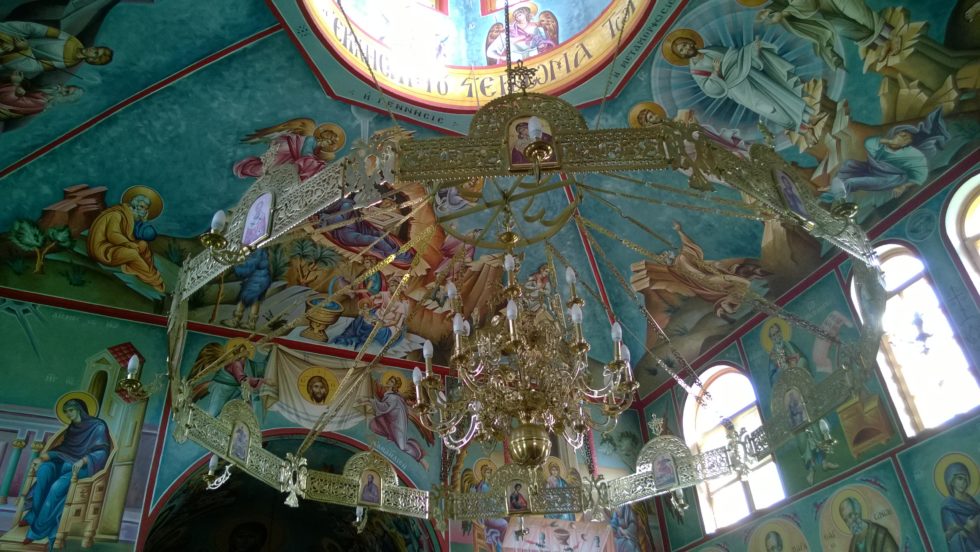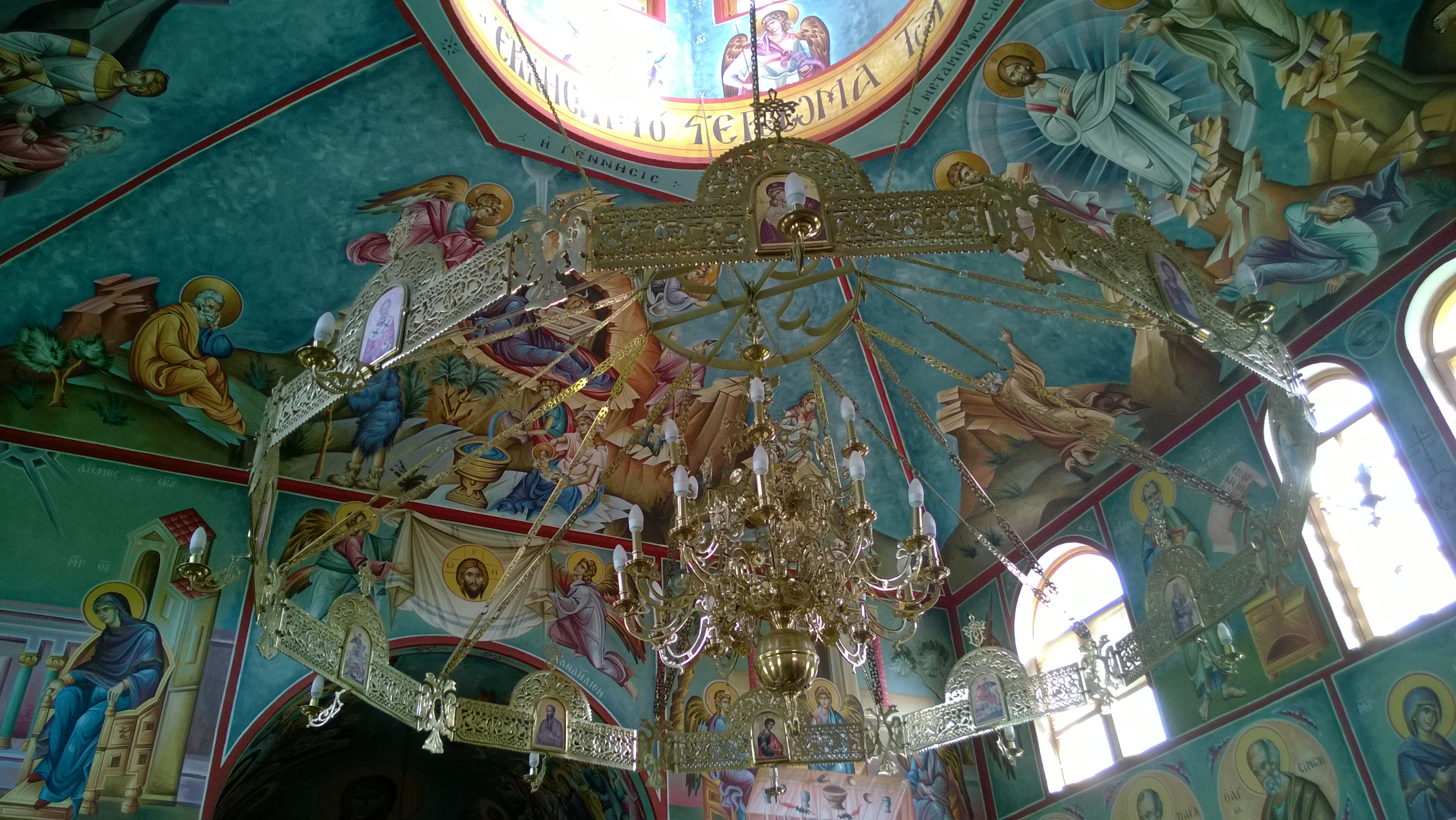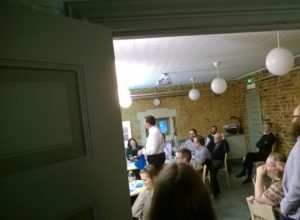
Previous entries in the series here:
Eyes to See, Ears to Hear
Our very first night and once again before the end of the week, we attended a Vespers service together in a tiny, beautiful church located on the grounds of the orthodox theological seminary attached to the university. From the moment the threshold of the Church of St. John the Theologian was crossed, the senses began to be engaged in a way that simply does not exist in the Evangelical experience. And though I would not be much engaged intellectually during the Vespers services—a lack of understanding of Greek or Church Slavonic rather hampers understanding the liturgical text, though I might have been hard pressed to understand the rapid-fire English as well if I had been subject to that—the total consummation of the senses at times was spiritually overwhelming.
At the entrance of the actual sanctuary of the church (my Orthodox friends will have to forgive me if I misname anything) each of the observant Orthodox believers bowed and crossed themselves. So began the first of many sense experiences. To me, this act was like an invocation, a sign of crossing over into a new world, one sanctified and set apart. Bowing seemed to me an act of obeisance, like a request for entrance to this otherworldly sacred space; the sign of the cross, then, was a sign of covenant, marking one’s membership in the Faithful. After, each worshipper walked to the icon displayed prominently in the center of the church, bowed, and kissed the face of its glass covering. Some also crossed the room to various icons on the walls, performing the same gesture, or sometimes merely bowing and performing the sign of the cross.
My vision was the next sense to be illuminated. Every facet, every surface in the room, every object was created with a unified aesthetic idea. Many great Biblical characters and later saints dotted the walls, each with their own icons. There were angels and disciples, kings like the Roman emperor Constantine, and others like Constantine’s mother beside him. Reserved for a place of honor above the altar was the image of Christ Himself. Christ also adorned the wall to the altar’s right, and Mary (venerated here as the Mother of God, or Theotokos) with the Christ-child adorned the wall on its left. Everywhere the eye was drawn, something beautiful was illuminated. A great chandelier hung in the center of the room, likewise decorated with smaller icons and other elegant, gilded designs.
It gave me pause, because according to the philosophy that dominates the design and decoration of a typical evangelical sanctuary, a church should remind us of our mundane state, being humbled before God; nor should there be any images, save perhaps a simple cross, to prevent us from being distracted from the real object of worship (God Himself) by any representation of Him or His saints. The vision of the orthodox church however, had this same effect of humbling. One is compelled to feel humility surrounded by such loveliness, and the whole aesthetic effect of the sanctuary is to draw one toward the altar and particularly to the image of Christ over it.
Soon, the service began and a long series of recitations, chants, and hymns were heard. This was the ignition of the sense of hearing, and it continued throughout the service. I wrote rather extensively of my encounter with the music and songs of the conference-goers in Finland already, so I won’t add much more, with the exception of some special moments that occurred later. Shortly after the service began, while the chant was still filling the air, the priest began to distribute (there has to be a more elegant word…) the incense using a censer, the rhythmic sound of the metal chain adding a soothing undertone to the chant. The fragrance filled the room quickly. As someone unused to it, I found it had a slight sense of otherness to it, perhaps both evoking the Holy as well as the eastern roots of the church.
The only other sense not yet brought into play was taste. Of course, if this were the normal Divine Liturgy on a Sunday morning, that too would come to pass at the climax of the service when the whole congregation took part in the Holy Eucharist together. All five senses, ignited in unison—the consummation of the physical and spiritual experiences. It gives new meaning to the Biblical phrase, “taste and see that the Lord is good,” when you are not merely tasting, but when every sense is overwhelmed by His Presence. The sense experience at Vespers was pervasive, though, so when the service seemed to stretch out in length, the intensity of the sense-ignition was somewhat lost. Fading to the background, I could almost be lulled into inattention, especially with my lack of understanding of the words being recited or chanted.
This was when those special moments tended to occur, when I would be suddenly pulled out of a resting, passive state into the present. Often, at the end of a long solo chant or recitation, the choir would suddenly strike up a hymn. The spectacular transformation from solemn monophony to a glorious polyphony would be marked in the congregation by making the sign of the cross and bowing to the altar and the image of Christ above it once more. Somehow, the intersection of these things: the uplifted music, crescendoing into brilliance, the focus on the image of Christ, the lingering scent of incense in the air, and most of all the placing of the symbol of Christ on our own bodies, marking first the head, the domain of the rational, then the stomach, the domain of the carnal, then right to left across the chest, marking our breath—the sign of life, and finally ending over our hearts, the seat of emotion and our sense of beauty and meaning, somehow the confluence of all these things resulted in a magnificent transcendent moment. The feeling that the Divine was here among us was overwhelming, bringing up images of Michelangelo’s The Creation of Adam, where just for a moment, we can almost touch the hand of God.
The whole experience seemed wrapped in mystery to me. For the next entry, I will write on the orthodox and their attachment to the mystery of Christ, which ties in well with what I have written so far.
0



